A tribal Hakkari rug in excellent condition, coarse and shaggy full pile
The design has the irregular charm and improvised nature one often encounters in tribal weavings. It is derived from the coupled column prayer rug design type according to Beattie ('Coupled column prayer rugs', Oriental Art, Vol. IX, No. 4). It is not a prayer rug anymore (it is also too large for that type) but still a double mihrab rug. A somewhat similar but older rug is shown in rug No. 109 of Brüggemann and Böhmer's Rugs of the Peasants and Nomads of Anatolia. The two red-ground beams, with star-filled octagons as decorating motive, have developed from the three field compartments between coupled columns in Ottoman court style prayer rugs (for a prototype, see, for example, fig. 44 in W. Denny's Anatolian Carpets). The 3 fields between the coupled columns have over time become objects in their own right - beams connected by a horizontal beam. So at some point in the design evolution a figure-ground switch has happened.
In this rug (as in Fig. 108 and 109 of the Brüggemann and Böhmer book) the number of vertical beams has been reduced to two. The horizontal connection has disappeared. Diamond-based large hooked ornaments and some scatter motives fill the spandrels above and below the two beams. The central space between the beams has been compartmented and filled with various small to tiny motives.
The crowning motives at the end of the beams still echo the ornamental capitals of the colomns. There is even an indication of the parapet above the spandrels, reduced to a narrow strip showing coarse flower motives, like those in the secondary border.
The main border employs an east-anatolian motive reminiscent of (or derived from) the 'Ak su' motive found in Turkmen Saryk and Salor rugs (again, you may compare the text to fig. 97 in the Brüggemann and Böhmer book). It is interesting how this Ak su motive in some parts of the left side border is handled in a very casual manner; the outlines of the motive dissolve to a wavy band playing around the central filler motive, a square with checkerbord inset. The border ground irregularly mixes blue and dark brown, with more brown nearer the top. The outer secondary border shows a design import from Persia, a coarse and rather erratic rendering of a Persian floral meander border type which is also sometimes called Badam or almond design. It occurs frequently in Southpersian but also in Caucasian rugs.
The rug measures 6ft.9in. x 3ft.10in. (208cm x 117cm). Full long pile with no discernable wear, very meaty handle. The rug is slightly crooked, like many Kurdish tribal weavings, and does not lie completely flat at the bottom end. The knotting is very coarse, the structure gabbeh-like with variously 3 - 6 weft shots after each row of knots (see image of the back), 5 x 5 knots per inch, ca. 25 kpsi, symmetrical knots. The pile is from one strand of slightly twisted long staple wool, the warp is from thick s-plied pink and in other areas off-white wool (the pink does not look a result of bleeding), the wefts are dark to medium brown wool (probably natural fleece colour). At the ends, there are two narrow red flat-woven kilims, wider at the top (ca 1 inch), narrower at the bottom (ca. 1/2 inch). The selvages are from four cords wrapped in figure 8 manner alternating orange and dark brown wool, with some red used as well.
The rug is dominated by a tonality of red, blue and orange, with white heavily outlining the beams and acting as secondary border ground colour. The beams show a beautifully abrashed medium to brick red, the field and most of the main border ground employ a dark indigo with lighter streaks. The blue is interspersed with dark brown especially near the top (perhaps the weaver saw she would rum out of indigo as the rug neared completion). Then there is a pleasing and varied orange dominant in the spandrels and parapet that is probably synthetic but shows variation (or abrash), some areas being paler, others more saturated and rusty. Streaks of orange are also found in the madder-red beams.
The condition is excellent, no discernable wear, no holes or cuts. Very full and shaggy pile (perhaps 1/2 inch long). A highly sturdy and durable construction, can take any floor use. No repairs I can detect apart from two small areas of repiling of a few rows in border folds, one 1/3 down the left border and the other, hardly noticeable, 2/3 down the right border (see detail image of the more noticeable left side repair). The rug is clean (though not recently washed) and has no odour, no rot, no stains or stiff areas.
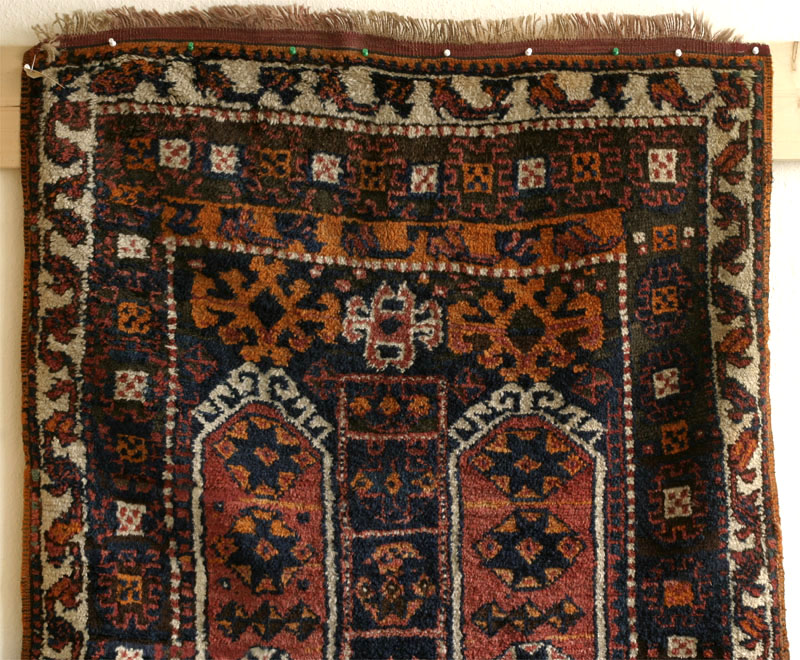
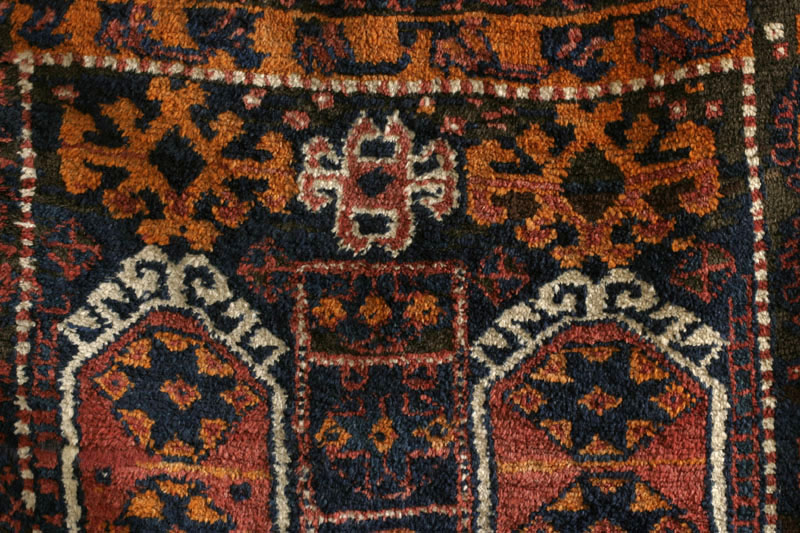
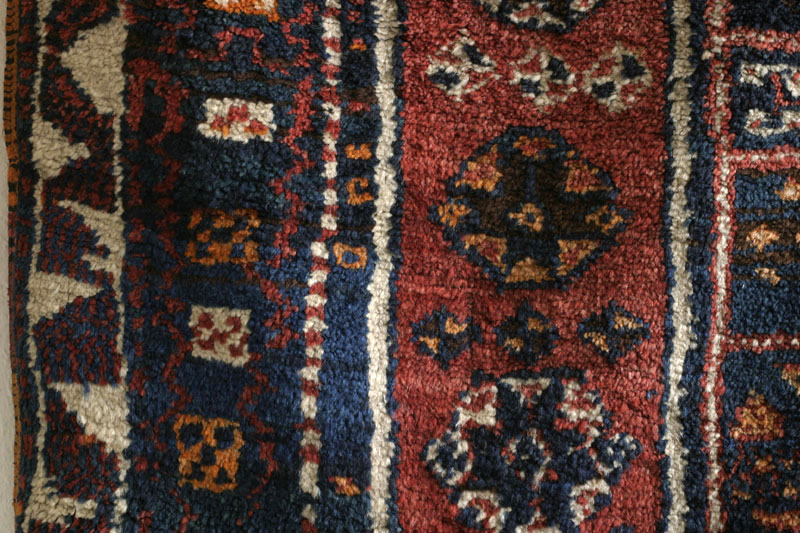
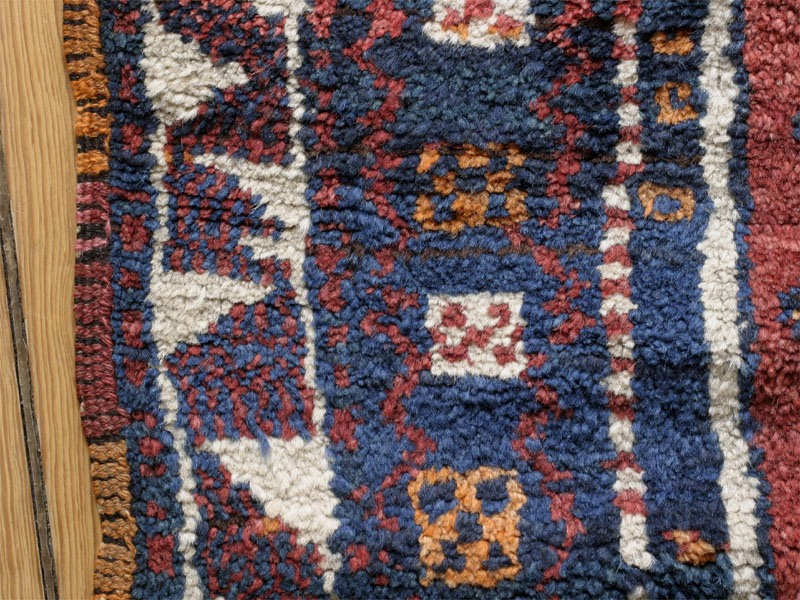
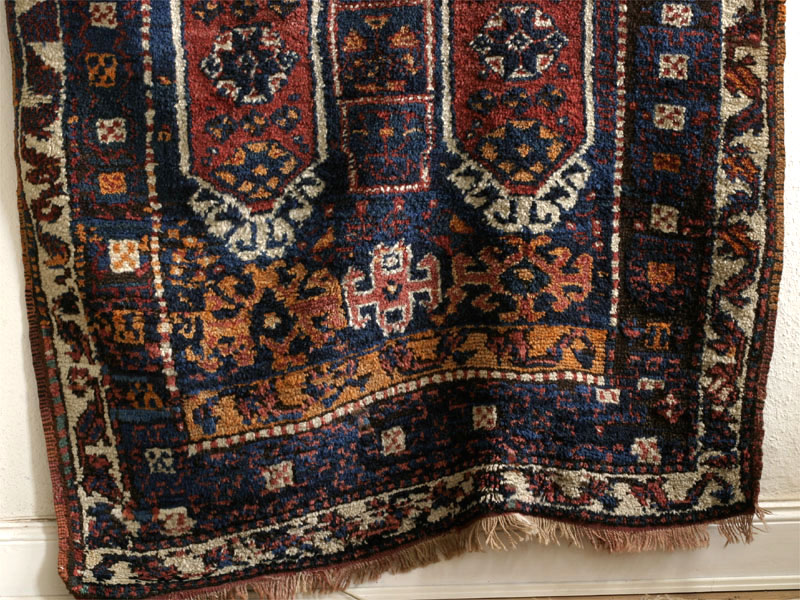
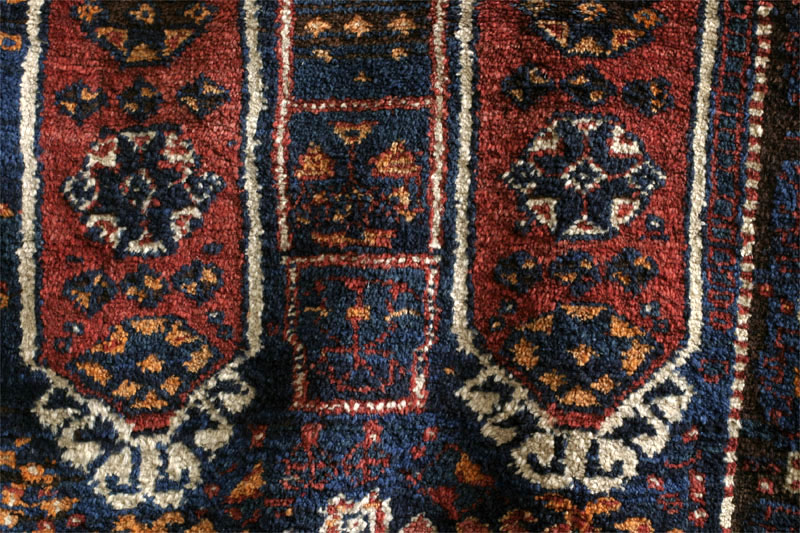
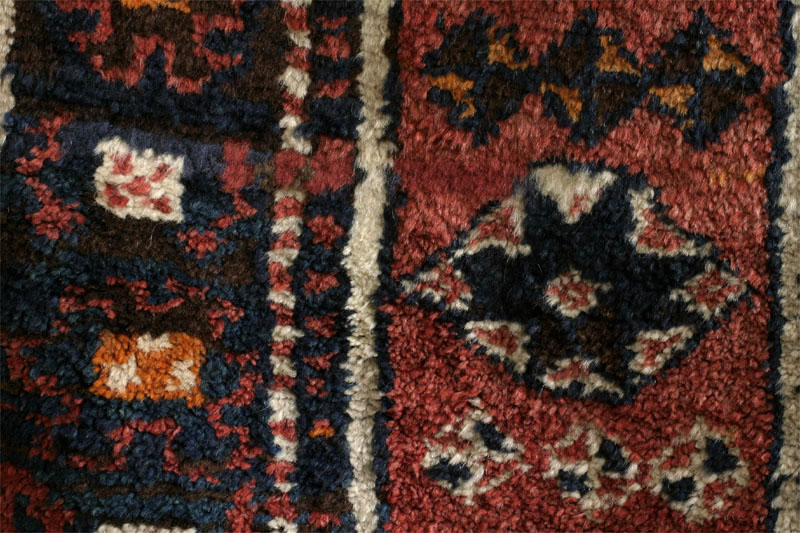
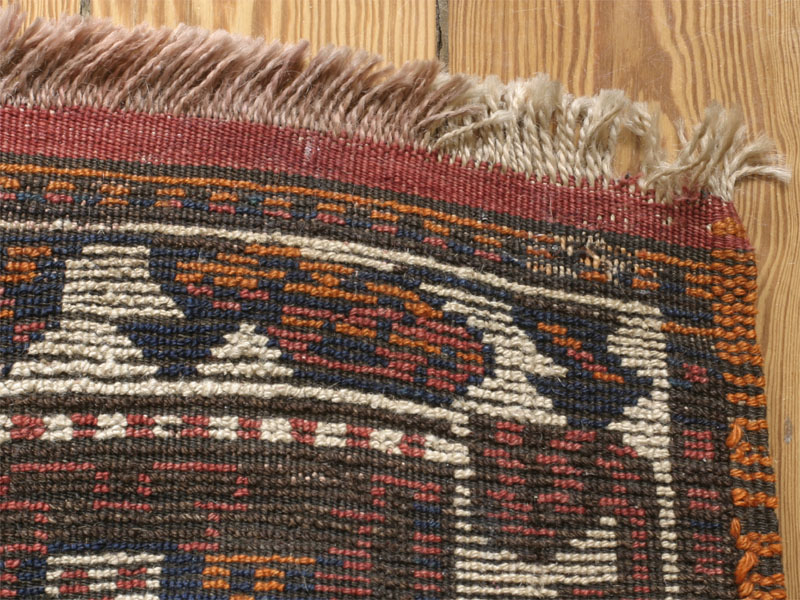
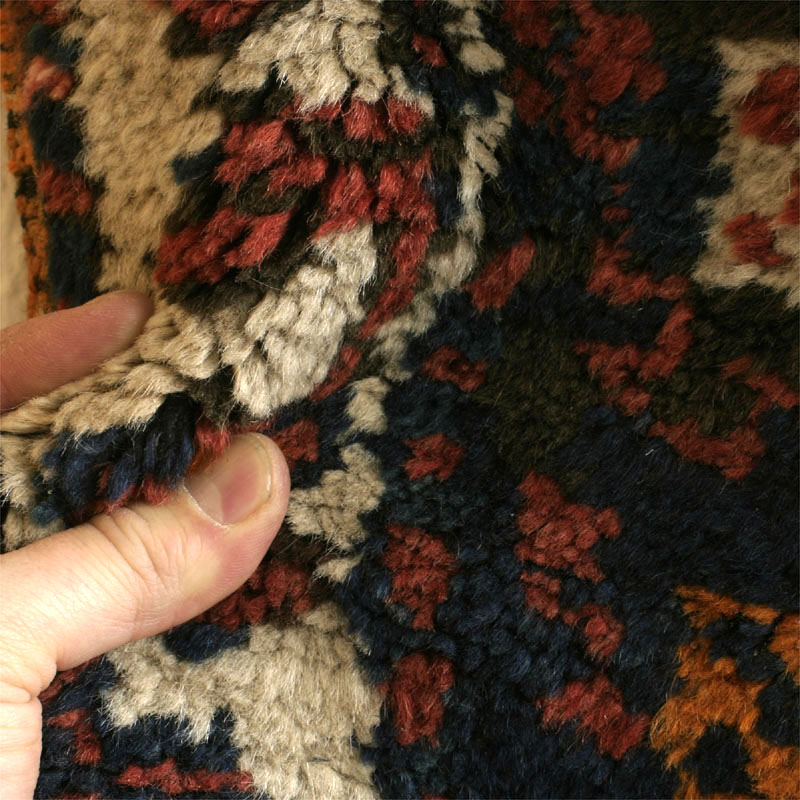
Ein kurdischer Nomadenteppich, Hakkari-Gegend, Südost-Anatolien ca. 1900-1920
Der Teppich zeigt charmante Unregelmäßigkeiten und Improvisationen, wie oft in Nomaden-Arbeiten. Das Design ist abgeleitet von den ottomanischen Doppelsäulen-Gebetsteppichen. Aus den drei Feldern zwischen den Doppelsäulen ist durch Figur-Grund-Tausch ein balkenartiges Motiv entstanden, das jetzt mit achteckigen, in Oktagone eingesetzten Sternen gefüllt ist.
Die Krönung der Balken verweist noch auf die Kapitäle der einstmaligen Säulen. Die Spandrille ober- und unterhalb der Balken ist mit Hakenrauten und Streumotiven gefüllt, ebenso der in Feldabschnitte geteilte Zwischenraum zwischen den beiden Balken. Ein abschließendes Band oben und unten zur Hauptbordüre hin erinnert an die Brüstung, die sich in vielen anatolischen Gebetsteppichen oberhalb der Bögen und Spandrillen anschließt.
Das Motiv der Hauptbordüre ist abgeleitet vom Ak su Motiv, dass sich in vielen Turkmenischen Teppichen findet und auch früh in die ostanatolischen Teppiche Einzug gehalten hat. Auf der linken Seite ist die äußere Kontur sehr lose gehandhabt u. verschmilzt z.T. zu einem lockeren Band.
Der Teppich misst 208 x 117 cm. Am unteren Ende wellt er sich etwas, liegt nicht völlig flach auf. Kann vom Fachmann durch Aufspannen korrigiert werden. Symmetrischer (türkischer) Knoten, 5x5 Knoten pro Inch also recht grob geknüpft, Ketten liegen auf einer Ebene, mit 3 - 6 Schüssen nach jeder Knotenreihe (siehe Bild der Rückseite).
Eine Palette, in der Indigoblau, Krapprot und Orange dominieren. Das Blau ist gemischt mit Dunkelbraun, bes. zum oberen Ende hin. Weiße Wolle für die Umrandung der Balken u. den Grund der Nebenbordüre. Das Orange ist wohl synthetischen Ursprungs, ist aber angenehm abschattiert (Abrasch) und nicht grell.
Sehr gut, feste und grobe Knüpfung mit 25 kpsi (5 x 5 Knoten pro Inch), dichter und langer Flor ohne erkennbare Abnutzung. Keine Ausblutungen, keine ausgeblichenen Spitzen, keine Flecken, Löcher o. Risse. Keine Reparaturen ausser zwei kleinen Ausbesserungen von 2 Trittfalten am Rand (die größere ist in einem Detailbild sichtbar). Der Teppich ist sauber und geruchsfrei.